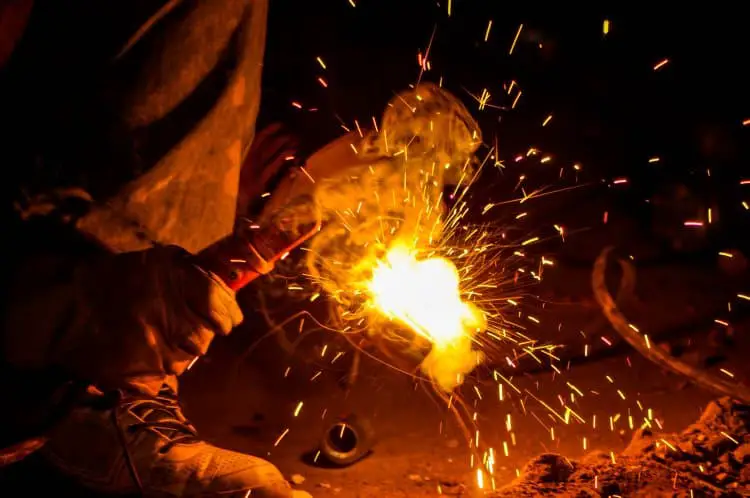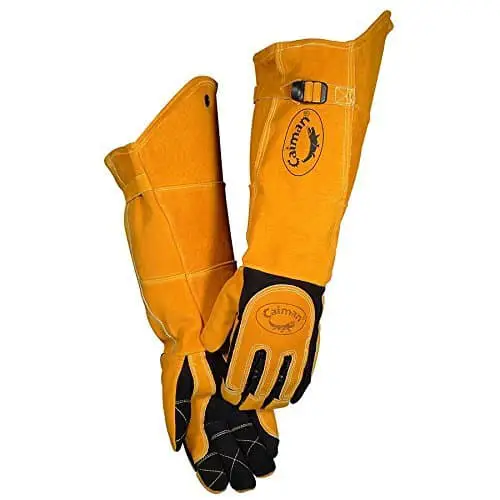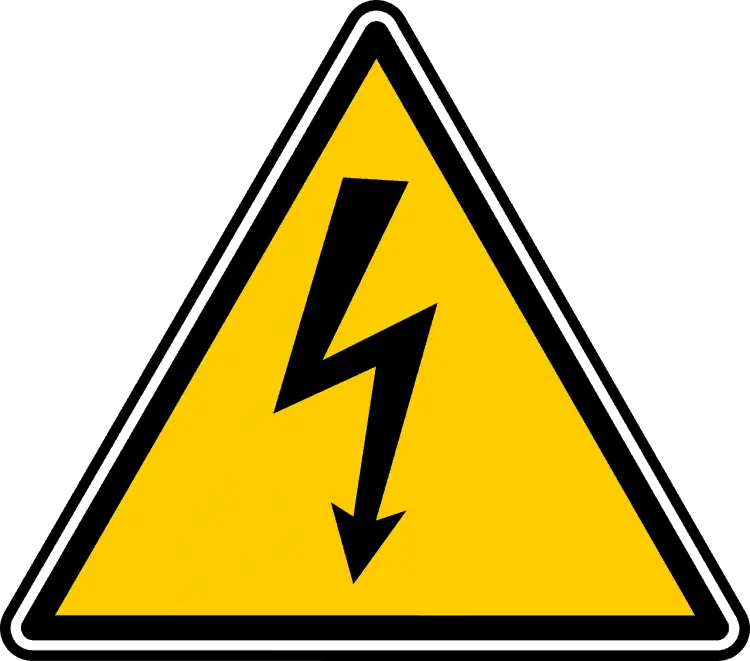This post contains affiliate links to products, services, or education. We may receive a commission for purchases made through links.
When compared to the cost of some of the equipment and protective gear used in welding, welding gloves are on the low-end, cost-wise. But that is not to say they’re on the low end, importance-wise. Time-tested, sage advice from those who know a thing or two about welding says to buy the best you can afford for all phases of the welding process – especially safety. That goes for welding gloves.
Are welding gloves shockproof? Welding gloves do not conduct electricity, so they are considered shockproof. They protect the wearers’ hands from electrical shock, extreme heat, ultraviolet radiation, infrared radiation, physical cuts and scrapes. They will not prevent the current from passing through other parts of the body and should not be used in place of an electrical ground or common sense.

It might be tempting to scrimp on a portion of the welding outfit that doesn’t represent a heavy investment, but saving a few bucks on welding gloves isn’t smart.
The amount of current you apply to your work a few inches from your hands is staggering. Not only electrical current, but massive doses of heat pose a grave hazard to your hands and your health.
Read more about using good leather gloves for welding here.
Get Some Gloves

Opposable thumbs are what sets humans apart from all lesser species, giving us the ability to grip, turn, hold and manipulate objects with relative ease.
In the welding process, the thumb is where the action – and the danger – is. The thumb holds the welding torch and maintains control of it throughout the welding pass.
Therefore, any welding glove design needs to incorporate a design that fully protects the thumb, yet allows it to apply maximum grip strength wherever it’s needed.
And while welding gloves have well-insulated sheaths for all the fingers, it’s clear that the thumb is the star of the show.
There are such things as welding mittens – where the fingers are bunched together in one pocket, and the thumb is independent, but welding mittens are not as flexible as gloves, and most welders avoid them.
Welding gloves also have extra-large cuffs to protect against welding spatter, which is an unwanted occurrence, but one that nevertheless happens, even to seasoned professionals.
The most popular material for welding gloves is heavy top leather or split leather. When a section of leather is split, the top part is more pleasant in appearance and is called top leather, but the underlying layer – called split leather – is just as strong.
The leather is derived from the hides of livestock and even game animals, and the choice of material is generally directed by the intended use of the glove. At any thickness, leather is not a conductor of electricity.
Type of Welding Gloves
- TIG Welding Gloves – The precise nature of TIG welding requires as much dexterity as possible. TIG welding gloves are most often made from cow, pig, or goat hide and forego maximum protection in favor of flexibility.
- MIG Welding Gloves – MIG welding involves the introduction of consumables to the welding process – in this case, automatically-fed wire that melts at the point of contact with the base metal. Here, protection is more important than dexterity, so manufacturers use thicker selections of cow, pig, or even deer hides.
- Stick Welding Gloves – Stick welding, where the consumable is held in one hand while the torch is held in the other, requires the ultimate in protection with the least amount of dexterity. Stick welding gloves are made from heavy cow hides or elk hides.
Evaluating Welding Gloves for Purchase
You can purchase welding gloves that meet all the safety requirements of the particular type of welding you intend to use while wearing them, but there are still quality issues that will make one brand stand out above another.
In the old days, if you wanted to buy a pair of welding gloves, you got in the pickup truck and drove to the supplier and tried a few on.
You would check the comfort, look over the stitching, pick up a few dimes to test the gloves’ flexibility, etc.
But, what if you live in an area where suppliers have dried up or transitioned to an online presence instead of a brick-and-mortar store?
This is where user reviews are immensely helpful. Most ordering websites have sections where they post reviews from previous buyers.
And while there may be a couple of “homers” in there (people who are encouraged to boast about said product), most of the reviews are legitimate.
Read the comments from people who bought those welding gloves and see how they liked them.
If you are fortunate enough to have a trusted local supplier for welding gloves, here are some specifications to be aware of:
- Extra leather between the thumb and forefinger. This is the most likely spot for glove failure over time. The best gloves will not only have extra leather (or, in some cases high-grade polyester) in this portion of the hand but an extra row of stitching as well.
- Protective coating on leather. This can also be something the user can provide. It keeps the leather from burning down to the insulation.
- Insulation. Here, the insulation is for heat, not electrical current. The insulation, usually made of fleece, not only shields the hands against heat but also wicks perspiration away and provides comfort.
Preventing Electric Shock While Welding
Wearing welding gloves is just the start, when protecting yourself against electric shock while welding.
Shocks can be administered to the body through the feet, arms, legs, head, knees – any body part that comes between two conductive surfaces where voltage is present.
The welding process generates open voltages of 20-100 volts, but inside the welding machine, voltages can run as high as 575 volts. Injury can occur at voltages as low as 50 volts, depending on conditions.
Electricity doesn’t seek conductive materials. It seeks the ground and will take the path of least resistance to ground.
Conductive materials make a convenient path for it to take.
Following a few common-sense safety precautions can greatly enhance your safety and isolate you from the possibility of electric shock.
The Welding Circuit Should Not Include You!

The most common way welders receive electric shock is by carelessly putting themselves into the welding circuit.
In a welding circuit, current flows from the welding machine through the electrode jumps across a gap and runs through the work metal, which is grounded to the welding machine case in most instances.
If the operator is insulated with dry welding gloves, a heavy welding jacket, and wearing non-conductive footwear, he or she should be adequately protected against shock.
However, any breakdowns in the material of this protective wear will expose the wearer to the possibility of shock.
The electrode can have wear and tear inside, and any break in the continuity can cause the current to run through parts not intended to carry it, such as the handle.
The grounding clip and cable should likewise be without imperfections. Anything that causes an electric current to run where it’s not supposed to constitutes a hazard that requires immediate repair.
As an additional precaution, never stand between the work area and the grounding clamp if possible.
Try to stand either “uphill” from the arc or “downhill” from the clamp – never in between.
Ground Your Work Table?
Welders disagree on the necessity of grounding anything other than the job metal to the welding machine cabinet.
Many experts say this creates a complete circuit, which should not pose a threat to a user who is adequately protected by his clothing.
However, as a secondary precaution that provides an additional path of least resistance, some welders ground their metal work table to the shop building or directly to grounding rods.
This can provide crucial protection in case there is a break in the welding circuit, or there is a malfunction inside the machine.
You can read more about the importance of grounding while welding here.
Sources:
- https://www.globalspec.com/learnmore/manufacturing_process_equipment/safety_personal_protective_equipment/welding_gloves
- https://www.lincolnelectric.com/en-us/education-center/welding-safety/Pages/electric-shock-faqs.aspx
- https://www.lincolnelectric.com/en-us/support/welding-solutions/Pages/Five-potential-welding-safety-hazards.aspx
- https://www.superiorglove.com/blog/how-to-choose-welding-gloves
